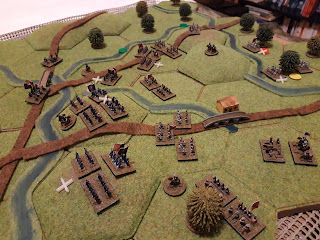Having painted some toys, I thought it was best to try out some rules. For face-face play I'm inclined to go with the original version of Horse, Foot and Guns (the 1991 version, not the more recent bloatfest). For remote games, I was drawn back to Richard Brooks 'Terrible Swift Rules', but with some revisions to the combat system to make it bit less of a maths exercise. I was also very taken with the unit activation system used in Belle Epoque, and it will make a good substitute for the cards and dice system used in the original. I've played loads of nineteenth century battles using these, but they are getting a bit old now and in need of an update.
I did a battlefield for 1st Bull Run at one hex to 1km. This is based on the Volley and Bayonet scenario. The Bull Run is at the top, Centreville (and the US Army) is off the top edge, while most of the Confederate force is off to the east with just token forces at Stone Bridge and the ford. Henry Hill, the pivot of the battle, is the one in the middle. The only towns are Sudley Springs and Newmarket, both too small to have any tactical significance.
The situation on Turn 7. The Union have just bludgeoned their way onto Henry Hill, but Sherman is in big trouble across Bull Run to the North as Jacksons brigade tears huge chunks out of the Union bridgehead. The routed remnants of the original defenders are reforming in the woods to the east.
As this is such a small battle, the manouvre units are brigades and each element represents around 1500 troops (better units like Jacksons are more like 1:1000). Turns are an hour.
The Confederate reinforcements have arrived just in time to save the day and lined up for a massive counterattack before the Union get dug in. Jeb Stuarts cavalry can be seen lurking in the foreground, but they are almost useless against infantry in good order. Better to find a flank or some disordered units ot beat up.
The assault goes in with close support from the Confederate guns. Stuart is waiting in reserve to exploit. As both sides have poor command staffs, it takes an age to get units deployed into combat formation and ready to attack.
A couple of hours of hard pounding ensue, but despite the initial Confederate superiority, the assault is beaten off and the shattered remains fall back. The defensive advantages were too great, and the intervention of a fresh Union brigade was decisive in tipping the balance. It looks like the rebellion is over before it had really got going.
That all worked pretty well and I finished up in less than two hours. There were a few ropey bits to do with the influence of leaders, and actually pushing the toys around clarified some thoughts about to model the terrain effects (particularly all those creeks and fords). The activation system worked well and introduced a sensible amount of friction, and the revised combat system was a lot less maths heavy, albeit still very bloody unless one side had a big advantage - which at 1st Bull Run, neither did.
I can tidy up the rough bits and I think that is a game. Unfortunately, I don't think it is going to work for remote play, as despite the grids, there is an awful lot of detailed decision making around the allocation of each units movement points to different actions and while it will work fine for f2f, I think it will be too much for remote play for the sorts of big battles I'm interested in. It will be worth a remote playtest session, but I think I'll revisit Belle Epoque or the Portable Wargame. The latter will need a huge re-write though.






Nice set up- can see why you think it would be a little fiddly for over zoom.
ReplyDeleteCheers,
Pete.
Well, it is the terrain which is the issue. And this is in civilised, cultivated Virginia! Goodness knows what things will be like down the Mississipi! On reflection, I think this would probably work remotely. I shall inflict it on you all at some point.
DeleteNicely sized battlefield / scope and the streams sitting on he hexsides rather than ‘in hex’ looks excellent.
ReplyDeleteI prefer water features to run along grid sides rather than through them, unless it is something huge (like the Rhine!)
DeleteSeems like the playtest went really well. A real mashup of mechanisms in there!
ReplyDeleteThanks Shaun. It actually worked very well, and looked nice too. Just getting the forces into positions they could fight each other felt like quite an effort, which seems appropriate for the late nineteenth century.
DeleteOh the lure of the Blue and the Grey
ReplyDeleteI need to get painting my Confederates
It strikes me that you have an awful lot on your painting pile Mark!
DeleteEpic scale ;)
ReplyDeleteYes. I saw that test strip you painted, very nice. Another bloggerv(Norm maybe?) cuts the strips up to get more bases out of them.
Delete